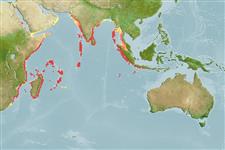Common names from other countries
>
Mulliformes (Goatfishes) >
Mullidae (Goatfishes)
Etymology: Parupeneus: Latin, parum, parvum = small + Peneus, the name of a river.
More on author: Lacepède.
Environment: milieu / climate zone / depth range / distribution range
นิเวศวิทยา
เกี่ยวกับทะเล,น้ำเค็ม เกี่ยวกับหินโสโครก; ระดับความลึก 0 - 80 m (Ref. 1602). Tropical; 24°N - 33°S, 28°E - 112°E
Indian Ocean: Oman and East Africa south to South Africa and east to Christmas Island and Java, Indonesia.
Included in the Parupeneus trifasciatus complex are: Parupeneus trifasciatus from the Indian Ocean; Parupeneus crassilabris from eastern Indian Ocean and the western Pacific, east to Fiji, Tonga, and the Caroline Islands; and Parupeneus insularis from the more eastern islands of Oceania.
ขนาด / น้ำหนัก / Age
Maturity: Lm ? range ? - ? cm
Max length : 35.0 cm TL เพศผู้/กระเทย; (Ref. 30573); common length : 27.0 cm TL เพศผู้/กระเทย; (Ref. 30573); น้ำหนักสูงสุดที่มีการรายงาน: 656.00 g (Ref. 125599)
เงี่ยงครีบหลัง (รวม) : 8; ก้านครีบอ่อนที่หาง (รวม) : 9; เงี่ยงครีบก้น: 1; ก้านครีบอ่อนที่ก้น: 7.
This occasionally schooling species inhabits lagoon and seaward reefs: juveniles on reef flats, adults tend to occur around rocky or coralline areas of high vertical relief. Feeds on crustaceans at daytime and on fishes and crab larvae at night. Also feeds on worms (Ref. 6113). Occurs in 3 color forms. The Indian Ocean form has 2 sharply defined wedge-shaped bars become narrower and sometimes end on the belly. The Indo-Australian form has 3 very distinct dark patches and rows of yellow spots on the sides. The Pacific Plate form has 2 wide bars that extend to the belly (Ref. 37816). Minimum depth reported taken from Ref. 128797.
Life cycle and mating behavior
Maturities | การสืบพันธุ์ | Spawnings | Egg(s) | Fecundities | ตัวอ่อน
Randall, J.E. and R.F. Myers, 2002. Parupeneus insularis, a new central pacific species of goatfish (Perciformes:Mullidae) of the P. trifasciatus complex. Zool. Stud. 41(4):431-440. (Ref. 45589)
IUCN Red List Status (Ref. 130435)
CITES (Ref. 128078)
Not Evaluated
Threat to humans
Harmless
Human uses
การประมง: การค้า
เครื่องมือ
Special reports
Download XML
แหล่งที่มาจากอินเตอร์เน็ต
Estimates based on models
Preferred temperature (Ref.
115969): 23.6 - 29, mean 27.8 (based on 1364 cells).
Phylogenetic diversity index (Ref.
82804): PD
50 = 0.5000 [Uniqueness, from 0.5 = low to 2.0 = high].
Bayesian length-weight: a=0.00813 (0.00535 - 0.01235), b=3.18 (3.06 - 3.30), in cm Total Length, based on LWR estimates for this species & Genus-body shape (Ref.
93245).
ระดับชั้นอาหาร (Ref.
69278): 3.5 ±0.50 se; based on food items.
ความสามารถในการกลับคืนสู่ปกติ (Ref.
120179): ขนาดกลาง, เวลาต่ำสุดที่จะทำให้ประชากรเพิ่มขึ้นเป็น 2 เท่าใช้เวลา 1.4 - 4.4 ปี (Preliminary K or Fecundity.).
Fishing Vulnerability (Ref.
59153): Low vulnerability (25 of 100).
